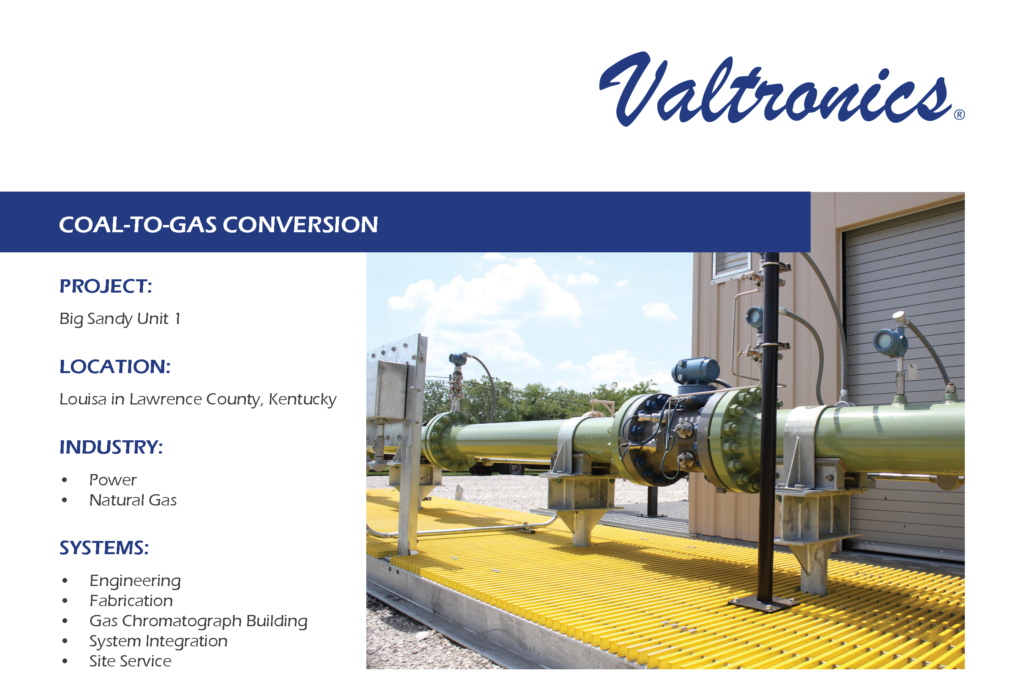PROJECT:
Big Sandy Unit 1
LOCATION:
Louisa in Lawrence County, Kentucky
INDUSTRY:
- Power
- Natural Gas
PRODUCTS AND SYSTEMS:
- Engineering
- Fabrication
- Gas Chromatograph Building
- System Integration
- Site Service
THE BACKGROUND
Columbia Gas Transmission, LLC applied November 2014 at the Federal Energy Regulatory Commission for approval of the gas pipeline that supports Kentucky Power’s plan to convert its coal-fired Big Sandy Unit 1 to natural gas.
Kentucky Power had already received Kentucky Public Service Commission approval to convert Big Sandy Unit 1 from coal to gas. The conversion was triggered in part by compliance needs under the federal Mercury and Air
Toxics Standards.
Open bidding was conducted between Aug. 15, 2014, and Aug. 22, 2014, to solicit binding offers for capacity on Columbia’s Line P system. At the close, there were no bids and all capacity was awarded to Kentucky Power.
On July 28, 2014, Columbia and Kentucky Power executed a Precedent Agreement, wherein the parties agreed that Columbia will provide up to 72,000 Dth/d of firm natural gas transportation service to Big Sandy Unit 1 beginning in 2016.
THEIR CHALLENGE
Every project begins with an extensive study phase in which a number of pros and cons must be considered before undertaking a project that could cost tens of millions of dollars. Typically from study phase to delivery of equipment takes about two-and-a-half years.
Kentucky Power needed to make the arrangements for the natural gas supply to be transported to the Big Sandy Plant by Columbia. Large gas pipelines often have to be run in excess of 20 miles from a suitable source, which can be very costly both for the hardware and the regulatory and permitting of a new natural gas corridor. Columbia proposed to construct approximately 3 miles of new 16-inch pipeline. The new 16-inch line PM214 commences at a tie-in with Columbia’s existing Line P in Wayne County, West Virginia; continues west where a 2,377 foot horizontal directional drill crossed beneath the Big Sandy River; and ends at a new Point of Delivery (POD) in the southwest corner of the existing Big Sandy Plant site near Louisa in Lawrence County, Kentucky. Once inside the plant perimeter, the transmitted gas must be regulated (reduced) in pressure, heated, metered, and then conveyed through a piping and valve train system, to the gas burners at the boiler front to the new low emissions gas firing system at the boiler interface. This equipment must be integrated with a complex flame safety, burner management and control system.
One of the most basic decisions in a conversion is to determine whether a complete replacement of the plant’s existing coal burners is required or to simply modify them for gas firing. Ultimately, this depends greatly on the age of the equipment and environmental regulations it must meet post conversion. Due to more stringent environmental permit requirements that often times come with the fuel conversion to gas, more significant modifications may be needed.
Due to the age of Unit 1, which was commissioned in 1963, and its relatively small size, Kentucky Power told the commission that the “relative economies of a large environmental investment” option to retrofit Unit 1 with pollution-control equipment “lacked sufficient scale to merit consideration.” Unit 1 would need to go from a 278-MW unit on coal to a 268-MW generator on natural gas.
OUR SOLUTION
Valtronics Solutions fabricated two measurement and regulation (M&R) skids and an analyzer building for the Big Sandy Unit 1 Coal-to-Gas conversion project. Connecting to one main header is a 12-inch ANSI 600 ultrasonic meter run supported by a 6’-4” x 41’ skid. A 12’ x 49’ skid supports 4-inch and 8-inch ultrasonic meter runs with a 2-inch turbine meter run. The measurement system includes actuated valves that provide automatic sequencing between each of the measurement runs. The varied meter setting sizes along with a 12” bypass allow for efficient measuring of fluctuations in flow due to seasonal and maintenance changes. A canopy over the measurement portion provides UV protection for temperature monitoring components, assisting in the prevention of inaccurate flow measurement.
A sample control and analysis system are housed within an 8’ x 12’ Gas Chromatograph (GC) Building containing a Mustang® Analyzer Distribution Panel, a Mustang® Modular Sample Control Panel and a Mustang Moisture Analyzer System which provides an Analytically Accurate® sample to the GC for gas composition analysis.
After the modular system was delivered, Valtronics Service teams completed site hookup by running gas sample lines and providing system commissioning. The converted gasfired plant is now ideally suited for deep load cycling to meet fluctuations in demand. This entire measurement system compliments the remaining coal fleet, providing quality baseload power generation.
